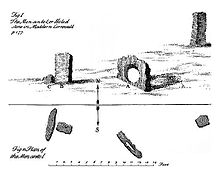The Mên-an-Tol (Cornish: Men an Toll) is a small formation of standing stones in Cornwall, UK (grid reference SW426349). It is about three miles northwest of Madron. It is also known locally as the "Crick Stone".
 Drawing and plan by W. Borlase, 1769
Drawing and plan by W. Borlase, 1769 Drawing by J. T. Blight, 1864
Drawing by J. T. Blight, 1864In 1749 the site was first archaeologically investigated by William Borlase, who also drew a plan. This shows that the megaliths were not in a line like today, but formed an angle of about 135°. Borlase also reported that farmers had taken away some stones from the area. From him comes the first written record of the myths and rituals.[1]
In the 19th Century the local antiquary John Thomas Blight published several drawings of the site, and made the first suggestion that the stones could be the remains of a stone circle.[2] In 1872 William Copeland Borlase, a descendant of the earlier Borlase, gave a more detailed description of the area.[3]
In 1932 Hugh O'Neill Hencken wrote the first modern archaeological report. He believed that the position of the stones was not the prehistoric arrangement, but had been significantly changed. He also thought that the holed stone might be part of a destroyed tomb. He was even told that local farmers with back or limb complaints would crawl through the hole to relieve their pain.[4]
In 1993, the Cornwall Historic Environment Service published a detailed report with the latest research results. They suggested that the standing stones originated from a stone circle which consisted of 18 to 20 stones. The holed stone, however, could be part of a nearby portal tomb. It also possible that the holed stone stood at the center of the stone circle and served to frame specific points on the horizon. Such a use of a holed stone is not known in other sites,[5] although the nearby stone circle of Boscawen-Un does have a central standing stone.



































Add new comment